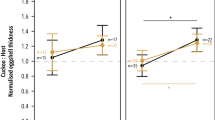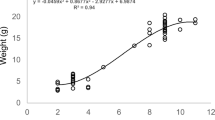Abstract
Eggs of several brood parasites have thicker and stronger shells than expected for their size. The present study evaluated the puncture resistance hypothesis for the occurrence of thick-shelled eggs in common cuckoos Cuculus canorus by investigating costs of cuckoo egg ejection in four Acrocephalus warblers—the great reed warbler A. arundinaceus, reed warbler A. scirpaceus, marsh warbler A. palustris and sedge warbler A. schoenobaenus. The three latter species all suffered ejection costs, while ejection was not costly in the larger great reed warbler. The occurrence of ejection costs was negatively related to host bill size. In the marsh warbler, we compared ejection costs in naturally parasitized nests and two experimental treatments, in which broods were parasitized artificially with great reed warbler and conspecific eggs. Hosts damaged their own eggs significantly more often when ejecting the thick-shelled cuckoo eggs than when ejecting the similarly sized but thinner-shelled great reed warbler eggs, providing some support for the puncture resistance hypothesis. Ejection of conspecific eggs did not involve any costs. Furthermore, contrary to predictions derived from the laying damage hypothesis, there was no evidence that egg damage was associated with cuckoo egg laying. Hosts damaging their own eggs during ejection were more likely to subsequently desert their clutches than those that did not. The frequency of clutches smeared with the contents of the ejected egg were positively related to the hypothesized difficulty of foreign egg puncturing. Potential advantages of thicker shells in common cuckoo eggs are discussed.
Similar content being viewed by others
References
Antonov A, Stokke BG, Moksnes A, Røskaft E (in press) Egg rejection behavior in a marsh warbler Acrocephalus palustris population heavily parasitized by common cuckoos Cuculus canorus. Auk
Ar A, Rahn H, Paganelli CV (1979) The avian egg: mass and strength. Condor 81:331–337
Brooker MG, Brooker LC (1991) Eggshell strength in cuckoos and cowbirds. Ibis 133:406–413
Clark KL, Robertson RJ (1981) Cowbird parasitism and evolution of anti-parasite strategies in the yellow warbler. Wilson Bull 93:249–258
Cramp S (ed) (1992) The birds of the Western Palearctic. Warblers, vol VI. Oxford University Press, Oxford
Davies NB, Brooke M de L (1988) Cuckoos versus reed warblers: adaptations and counteradaptations. Anim Behav 36:262–284
Davies NB, Brooke M de L (1989) An experimental study of co-evolution between the cuckoo, Cuculus canorus, and its hosts. I. Host egg discrimination. J Anim Ecol 58:207–224
Edvardsen E, Moksnes A, Røskaft E, Øien IJ, Honza M (2001) Egg mimicry in cuckoos parasitizing four sympatric species of Acrocephalus warblers. Condor 103:829–837
Gärtner K (1981) Das Wegnehmen von Wirtsvogeleiern durch den Kuckuck (Cuculus canorus). Ornithol Mitt 33:115–131
Gaston AJ (1976) Brood parasitism by the pied crested cuckoo Clamator jacobinus. J Anim Ecol 45:331–348
Honza M, Picman J, Grim T, Novák V, Čapek M Jr, Mrlík V (2001) How to hatch from an egg of great structural strength. A study of the common cuckoo. J Avian Biol 32:249–255
Honza M, Procházka P, Stokke BG, Moksnes A, Røskaft E, Čapek M Jr, Mrlík V (2004) Are blackcaps current winners in the evolutionary struggle against the common cuckoo? J Ethol 22:175–180
Hoyt OF (1979) Practical methods of estimating volume and fresh weight of bird eggs. Auk 96:73–77
Kramer GH, Lemon RE (1985) Song switching and agonistic stimulation in the song sparrow: five tests. Anim Behav 33:135–149
Lack D (1968) Ecological adaptations for breeding in birds. Methuen, London
Lessells CM, Boag PT (1987) Unrepeatable repeatabilities: a common mistake. Auk 104:116–121
Lindholm AK (2000) Tests of phenotypic plasticity in reed warbler defences against cuckoo parasitism. Behaviour 137:43–60
Lorenzana JC, Sealy SG (2001) Fitness costs and benefits of cowbird egg ejection by gray catbirds. Behav Ecol 12:325–329
Lotem A, Nakamura H, Zahavi A (1995) Constraints on egg discrimination and cuckoo–host co-evolution. Anim Behav 49:1185–1209
Martin-Vivaldi M, Soler M, Møller AP (2002) Unrealistically high costs of rejecting artificial model eggs in cuckoo Cuculus canorus hosts. J Avian Biol 33:295–301
Moksnes A, Røskaft E (1995) Egg-morphs and host preference in the common cuckoo (Cuculus canorus): an analysis of cuckoo and host eggs from European museum collections. J Zool (Lond) 236:625–648
Moksnes A, Røskaft E, Braa AT (1991) Rejection behaviour by common cuckoo hosts towards artificial brood parasite eggs. Auk 108:348–354
Moksnes A, Røskaft E, Bicík V, Honza M, Øien IJ (1993a) Cuckoo Cuculus canorus parasitism on Acrocephalus warblers in Southern Moravia in the Czech Republic. J Ornithol 134:425–434
Moksnes A, Røskaft E, Korsnes L (1993b) Rejection of cuckoo (Cuculus canorus) eggs by meadow pipits (Anthus pratensis). Behav Ecol 4:120–127
Moksnes A, Røskaft E, Solli MM (1994) Documenting puncture ejection of parasitic eggs by chaffinches Fringilla coelebs and blackcaps Sylvia atricapilla. Fauna Norv Ser C 17:115–118
Moksnes A, Røskaft E, Greger Hagen L, Honza M, Mørk C, Olsen PH (2000) Common cuckoo Cuculus canorus and host behaviour at reed warbler Acrocephalus scirpaceus nests. Ibis 142:247–258
Moskát C, Honza M (2002) European cuckoo Cuculus canorus parasitism and host’s rejection behaviour in a heavily parasitized great reed warbler Acrocephalus arundinaceus population. Ibis 144:614–622
Moskát C, Szentpéteri J, Barta Z (2002) Adaptations by great reed warblers to brood parasitism: a comparison of populations in sympatry and allopatry with the common cuckoo. Behaviour 139:1313–1329
Nager RG, Monaghan P, Houston DC (2001) The cost of egg production: increased egg production reduces future fitness in gulls. J Avian Biol 32:159–166
Øien IJ, Moksnes A, Røskaft E, Honza M (1998) Costs of cuckoo Cuculus canorus parasitism to reed warblers Acrocephalus scirpaceus. J Avian Biol 29:209–215
Picman J (1989) Mechanisms of increased puncture resistance of eggs of brown-headed cowbirds. Auk 106:577–583
Procházka P, Honza M (2003) Do common whitethroats (Sylvia communis) discriminate against alien eggs? J Ornithol 144:354–363
Procházka P, Honza M (2004) Egg discrimination in the yellowhammer. Condor 106:405–409
Rahn H, Curran-Everett L, Booth DT (1988) Eggshell differences between parasitic and non-parasitic Icteridae. Condor 90:962–964
Rohwer S, Spaw CD (1988) Evolutionary lag versus bill-size constraints: a comparative study of the acceptance of cowbird eggs by old hosts. Evol Ecol 2:27–36
Rohwer S, Spaw CD, Røskaft E (1989) Costs to northern orioles of puncture-ejecting parasitic cowbird eggs from their nests. Auk 106:734–738
Røskaft E, Moksnes A, Meilvang D, Bicík V, Jemelíková J, Honza M (2002) No evidence for recognition errors in Acrocephalus warblers. J Avian Biol 33:31–38
Rothstein SI (1975) An experimental and teleonomic investigation of avian brood parasitism. Condor 77:250–271
Rothstein SI (1976) Experiments on defenses cedar waxwings use against cowbird parasitism. Auk 93:675–691
Schönwetter M (1979) Handbuch der Oologie, Band II. Akademie Verlag, Berlin
Schulze-Hagen K (1992) Parasitierung und Brutverluste durch den Kuckuck (Cuculus canorus) bei Teich- und Sumpfrohrsänger (Acrocephalus scirpaceus, A. palustris) in Mittel- und Westeuropa. J Ornithol 133:237–249
Schulze-Hagen K, Leisler B, Winkler H (1996) Breeding success and reproductive strategies of two Acrocephalus warblers. J. Ornithol 137:181–192
Soler M (1990) Relationships between the great spotted cuckoo Clamator glandarius and its corvid hosts in a recently colonized area. Ornis Scand 21:212–223
Soler M, Martínez JG (2000) Is egg-damaging behavior by great spotted cuckoos an accident or an adaptation? Behav Ecol 11:495–501
Soler M, Soler JJ, Martínez JG (1997) Great spotted cuckoos improve their reproductive success by damaging magpie host eggs. Anim Behav 54:1227–1233
Spaw CD, Rohwer S (1987) A comparative study of eggshell thickness in cowbirds and other passerines. Condor 89:307–318
Stokke BG, Moksnes A, Røskaft E, Rudolfsen G, Honza M (1999) Rejection of artificial cuckoo (Cuculus canorus) eggs in relation to variation in egg appearance among reed warblers (Acrocephalus scirpaceus). Proc R Soc Lond B 266:1483–1488
Stokke BG, Honza M, Moksnes A, Røskaft E, Rudolfsen G (2002) Costs associated with recognition and rejection of parasitic eggs in two European passerines. Behaviour 139:629–644
Swynnerton CFM (1918) Rejections by birds of eggs unlike their own: with remarks on some of the cuckoo problems. Ibis 6:127–154 (Tenth Series)
Visser ME, Lessells CM (2001) The costs of egg production and incubation in great tits (Parus major). Proc R Soc Lond B 268:1271–1277
Weary DM, Krebs JR, Eddyshaw R, McGregor PK, Horn A (1988) Decline in song output by great tits: exhaustion or motivation? Anim Behav 36:1242–1244
Weatherhead PJ (1991) The adaptive value of thick-shelled eggs for brown-headed cowbirds. Auk 108:196–198
Wyllie I (1981) The cuckoo. Batsford, London
Acknowledgements
We want to thank the staff at the Naturhistoriches Museum in Vienna, Austria, for allowing us to make bill measurements of the study species. We would like to thank all students and cooperators working in our Czech study area for assistance in the field. We are very grateful to Manuel Soler, Lesley Brooker and one anonymous referee for comments that significantly improved a previous version of the manuscript. B.G.S. was funded by the Research Council of Norway, grant no. 151641/432. All experiments complied with the current laws of Bulgaria and Czech Republic.
Author information
Authors and Affiliations
Corresponding author
Additional information
Communicated by M. Soler
Rights and permissions
About this article
Cite this article
Antonov, A., Stokke, B.G., Moksnes, A. et al. Eggshell strength of an obligate brood parasite: a test of the puncture resistance hypothesis. Behav Ecol Sociobiol 60, 11–18 (2006). https://doi.org/10.1007/s00265-005-0132-6
Received:
Revised:
Accepted:
Published:
Issue Date:
DOI: https://doi.org/10.1007/s00265-005-0132-6




